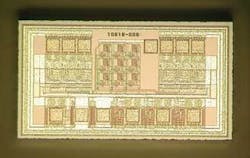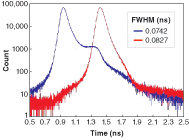Quantum Detectors: Single-photon detectors take quantum leaps
ALEXANDRE PAUCHARD, GREGOIRE RIBORDY, ALEXIS ROCHAS, LEONARD WIDMER, ROBERT THEW, AND WOLFGANG BECKER
Quantum detectors—including photodiodes, photoconductors, phototransistors, charge-coupled detectors (CCDs), and photomultiplier tubes—are devices that convert incoming photons directly into an electrical signal, as opposed to thermal detectors that rely on the conversion of incoming radiation to heat.
A growing number of applications require the detection of single photons—the ultimate limit in detector sensitivity. The availability of high-performance photon counters is crucial to continued progress in the fields of quantum information processing, quantum communication, fluorescence analysis, chemical or biological luminescence analysis, single-molecule detection, and light detection and ranging (lidar).
Non-solid-state photon counters
Among several photon-detection methods, photomultiplier tubes (PMTs) and microchannel PMTs have been produced industrially for a half century and have long since reached maturity.
Photomultiplier tubes have large active areas and are capable of detecting single photons. Consisting of a photoemissive cathode followed by an electron multiplier and an electron collector (anode), the timing resolution of conventional PMTs is limited to about 150 ps. A few PMTs have been optimized to operate in the near-infrared (NIR) wavelength range from 1000 to 1520 nm, but their quantum efficiency is poor—on the order of 1%.
When highly accurate timing is required, microchannel plates (MCPs) are preferred. Consisting of millions of conductive capillaries fused together (with diameters in the range of 4 to 25 µm), some MCPs can achieve very low timing jitter of about 25 ps. However, the devices are very expensive and their count rates are limited to a few megahertz. In addition, MCPs are fragile and bulky, operate under very high bias voltages (up to 3000 V), and are limited to about 20% quantum efficiency in the visible range.
Solid-state photon counters
When operated in a linear mode (below breakdown), avalanche photodiodes (APDs) are not sensitive enough to detect single photons because the achievable gain is too low. In a 100‑Mbit/s APD-based receiver operating at 1550 nm, sensitivity in the range of -54 dBm and bit-error rate (BER) of 1 × 10-6 can be achieved, which corresponds to about 280 photons per bit.
To detect single photons, APDs must be operated in the so-called Geiger mode. The idea is to bias the APD a few volts above the avalanche breakdown voltage, at which point the detector becomes extremely sensitive. When a photon is absorbed and triggers an avalanche process, it results in a huge increase in output current. This current then has to be quenched externally for the APD to return to a sensitive state.
Avalanche photodiodes have several technological limitations, however, such as high dark counts when thermal generation triggers avalanche events. Cooling the detector helps minimize the impact of these spurious counts; however, electrical carriers can be trapped inside the crystal and released at a later time causing afterpulses. Because the lifetime of trapping events increases when the temperature is reduced, there is a tradeoff between minimizing the dark counts and the afterpulses.
Because of excellent crystal quality, silicon APDs perform best in Geiger mode, with dark counts in the range of a few counts per second. Commercial photon-counting modules based on silicon APDs have been available since the early 1990s. To achieve maximum quantum efficiency in the red (70% at 700 nm), the devices have a thick depletion region of about 30 µm, resulting in very high timing jitter on the order of 500 ps.
Recent work has focused on reducing the depletion-layer thickness to trade off quantum efficiency in the red for better timing accuracy. id Quantique was first to commercialize silicon APDs (SPADs) manufactured in a commercially available CMOS foundry. The main advantage of this approach is that the APD and the active quenching electronics can be integrated on the same chip, which offers several advantages. First, the thin depletion-layer—in the micrometer range—results in an extremely low timing jitter of 40 ps. Second, APD arrays can be integrated on a single silicon die (see Fig. 1). Much larger, 32 × 32 APD arrays have already been demonstrated.1 Third, the detectors manufactured in a CMOS foundry are extremely reliable compared to nonstandard processes used by other manufacturers. Finally, the resulting detectors are extremely compact because all the vital organs are integrated on one small silicon die (see Fig. 2).In the near-IR spectrum, indium gallium arsenide/indium phosphide (InGaAs/InP) and germanium (Ge) APDs are the detectors of choice. These devices also can be deployed in photon-starved environments when operated in Geiger mode. Their quantum efficiencies are in the range of 10% to 20%—a great improvement over PMTs. Because of the lower crystal quality of the InGaAs/InP and Ge material systems, the dark-count rate of these APDs is much higher than that of silicon APDs. For the best InGaAs APDs, the dark-count rate is in the range of 40,000 counts/s when cooled to about -50°C. The APDs are operated in the “gated” mode: an excess voltage of a few volts is applied across the APD during a short gate period (typically 1 to 100 ns). Contrary to their silicon counterparts, InGaAs APDs suffer from a high density of afterpulsing, limiting the usable frequency to a few megahertz. A commercial photon counter for NIR detection has been available from id Quantique since 2002 and has been used extensively in a broad range of quantum cryptography and quantum teleportation experiments.3
Upconversion for NIR detection
The nonlinear process of upconversion can be exploited to go beyond the detection limits of InGaAs-based SPADs. Frequency upconversion allows an IR photon to be converted into a visible photon by using sum-frequency generation in nonlinear optical crystals to combine a weak input signal with a strong laser pump to yield a higher frequency (in other words, lower wavelength) output signal. One can then use a SPAD with much higher efficiency, and lower noise and afterpulse probability, to detect the upconverted single photons. While InGaAs-based photon counters can only operate in gated mode, upconversion-based detectors can operate in a continuous, free running mode.
Several research groups are working on upconversion techniques. In one experiment, photons at 1550 nm were upconverted to photons at 630 nm in bulk periodically poled lithium niobate (PPLN) crystals with 90% efficiency.4 The detector had good efficiency at 630 nm but low timing jitter.
For applications requiring low jitter and high count rates, thin SPADs can be used to advantage. Recently, Thew and colleagues demonstrated an upconversion detector with low jitter and megahertz raw-count rates. The detector was built using a PPLN waveguide, a pump laser at 980 nm, and a SPAD from id Quantique. The researchers showed that a gigahertz quantum-cryptography system based on this detector achieved raw bit rates in the megahertz range over 25 km.5
Although very promising candidates for high-sensitivity detection at telecom wavelengths, detectors based on upconversion will require additional improvements to become viable alternatives to commercial detectors. If obstacles such as nonlinear noise, polarization sensitivity, and the need for bulky optical components can be overcome, upconversion holds the promise of fast and free-running operation, with higher detection efficiencies in the NIR.
Superconducting detectors
Another way to improve the performance of single-photon counters beyond that of semiconductors is to take advantage of superconductivity. Several detectors have been developed, including transition-edge sensors and superconducting tunnel-junction devices, that can detect single photons and even resolve the number of photons reaching the detector. Such devices are slow but exhibit no dark counts and have efficiencies in the 20% to 40% range.
Superconducting single-photon detectors, on the other hand, are very fast (gigahertz-rate photoresponse, with a jitter in the tens of picoseconds), have quantum efficiencies in the 10% range at a wavelength of 1.3 µm, but are not able to resolve the number of photons in multiphoton pulses.
The main barrier to introducing superconducting detectors is the need for cryogenic cooling and the corresponding high price. Superconducting detectors are unlikely to be widely adopted unless high-temperature superconducting materials become available. The devices could then be cooled thermoelectrically, reducing the overall detector cost.
REFERENCES
1. C. Niclass et al., IEEE J. Solid-State Circuits, 1847 (September 2005).
2. W. Becker, Advanced time-correlated single-photon counting techniques, Springer, Berlin, Heidelberg, New York (2005).
3. I. Marcikic et al., Nature 421, 509 (2003).
4. M. Albota et al., Optics Letters 29(13) 1449 (2004).
5. R. T. Thew et al., New J. Phys. 8, 32 (2006).
ALEXANDRE PAUCHARD is vice president of engineering, GREGOIRE RIBORDY is CEO, ALEXIS ROCHAS is manager of detector developments, and LEONARD WIDMER is vice president of sales at id Quantique, Chemin de la Marbrerie, 3, 1227 Carouge, Geneva, Switzerland; ROBERT THEW is a post-doctorate in the Group of Applied Physics at the University of Geneva, 24 rue du Général-Dufour, 1211 Geneva 4, Switzerland; WOLFGANG BECKER is president of Becker & Hickl, Nahmitzer Damm 30, D-12277 Berlin, Germany; e-mail: [email protected]; www.idquantique.com.


